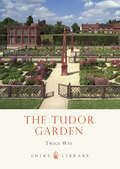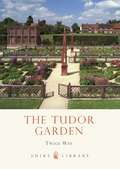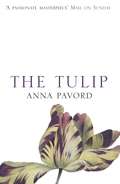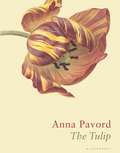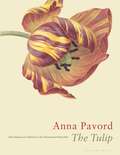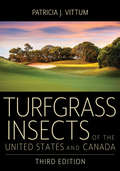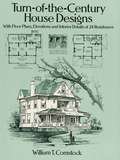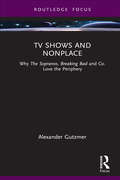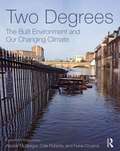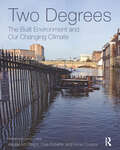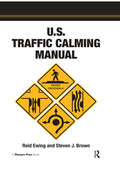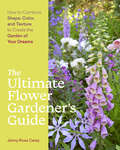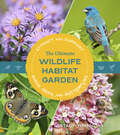- Table View
- List View
The Tudor Garden: 1485–1603 (Shire Library)
by Twigs WayContrived, colourful and cultured, the Tudor garden was a paradise on earth, given over to pleasurable pastimes and aesthetic effect. Artificiality was the fashion of the age, with clipped and twining plants vying for space with brightly painted woodwork and patterned beds.Renaissance discoveries reared their heads in royal gardens, where gilded and painted heraldic figures mingled with fantastical sundials and glittering fountains. Walls kept out the wild world beyond, while mounts afforded glimpses to new parklands and provided raised platforms for the banqueting houses of the wealthy. Ever-changing with newly introduced exotic plants, yet featuring year-round knot gardens, the Tudor garden was a vibrant pageant, and is given a suitably colourful celebration in this fully illustrated book.
The Tudor Garden: 1485–1603 (Shire Library #720)
by Twigs WayContrived, colourful and cultured, the Tudor garden was a paradise on earth, given over to pleasurable pastimes and aesthetic effect. Artificiality was the fashion of the age, with clipped and twining plants vying for space with brightly painted woodwork and patterned beds.Renaissance discoveries reared their heads in royal gardens, where gilded and painted heraldic figures mingled with fantastical sundials and glittering fountains. Walls kept out the wild world beyond, while mounts afforded glimpses to new parklands and provided raised platforms for the banqueting houses of the wealthy. Ever-changing with newly introduced exotic plants, yet featuring year-round knot gardens, the Tudor garden was a vibrant pageant, and is given a suitably colourful celebration in this fully illustrated book.
The Tulip: Twentieth Anniversary Edition
by Anna PavordTHE TULIP is not a gardening book. It is the story of a flower that has made men mad. Greed, desire, anguish and devotion have all played their part in the development of the tulip into the world-wide phenomenon it is today. No other flower has ever carried so much cultural baggage; it charts political upheavals, illuminates social behaviour, mirrors economic booms and busts, plots the ebb and flow of religious persecution. Pavord tells how the tulip arrived from Turkey and took the whole of Western Europe by storm. Sumptuously illustrated from a wide range of sources, this beautifully produced and irresistible volume will become a bible, a unique source book, a universal gift book and a joy to all who possess it.
The Tulip: The Story of the Flower that Has Made Men Mad
by Anna PavordAnna Pavord's now classic, internationally bestselling sensation, The Tulip, is not a gardening book. It is the story of a flower that has driven men mad. Greed, desire, anguish and devotion have all played their part in the development of the tulip from a wild flower of the Asian steppes to the worldwide phenomenon it is today. No other flower carries so much baggage; it charts political upheavals, illuminates social behaviour, mirrors economic booms and busts, plots the ebb and flow of religious persecution.
The Tulip: Twentieth Anniversary Edition
by Anna PavordA twentieth anniversary edition of the classic, featuring new material by the author. Anna Pavord's internationally bestselling sensation, The Tulip, is the story of a flower that has driven men mad. Greed, desire, anguish, and devotion have all played their part in the development of the tulip into a worldwide phenomenon. Today, the United States alone imports three thousand million tulip bulbs each year. No other flower has ever carried so much consequence; it charts political upheavals, illuminates social behavior, mirrors economic booms and busts, plots the ebb and flow of religious persecution. Why did the tulip dominate so many lives through so many centuries in so many countries? Anna Pavord, a self-confessed tulipomaniac, spent six years looking for answers, roaming through Asia, India, and the Ottoman Empire to tell how a humble wildflower of the Asian steppes made its way to Turkey and from there took the whole of Western Europe by storm. Sumptuously illustrated from a wide range of sources, this irresistible volume has become a bible, a unique source book, a universal gift book, and a joy to all who possess it. This beautifully redesigned edition features a new Preface by the author, a completely revised listing of the best varieties of this incomparable flower to choose for your garden, and a reorganized listing of tulip species, to reflect the latest thinking by taxonomists.
Turfgrass Insects of the United States and Canada
by Patricia J. VittumThe first edition of this reference work became known as the bible of turfgrass entomology upon publication in 1987. It has proved invaluable to professional entomologists, commercial turf managers, and golf course superintendents and has been used widely in college extension courses. This classic of the field is now in its third edition, providing up-to-date and complete coverage of turfgrass pests in the continental United States, Hawaii, and southern Canada.This revised volume integrates all relevant research from the previous two decades. It provides expanded coverage of several pest species, including the annual bluegrass weevil, invasive crane fly species, chinch bugs, billbugs, mole crickets, and white grubs. Patricia J. Vittum also provides detailed information on the biology and ecology of all major pests and includes the most current information on conditions that favor insect development and biological control strategies pertinent to each species.This edition will include more than 100 black-and-white images, including diagrams of life cycles, sketches of morphological characteristics, and charts highlighting seasonal activity. The book also includes 72 full-color plates (more than 500 color images), showing closeup pictures of most of the key insects (adult and immature stages) and damaged turf. The reader should be able to identify most turf insects through the use of this text. It is a critical reference work that any serious turf professional should own.
Turn-of-the-Century House Designs: With Floor Plans, Elevations and Interior Details of 24 Residences
by William T. ComstockThis inexpensive archive of handsome turn-of-the-century designs reprinted directly from a rare late Victorian volume contains plans for a variety of suburban and country homes that are both aesthetically appealing and moderate in cost. Included are plans for 24 cottages and houses in a wide range of styles, among them Queen Anne, Eastlake, and Colonial. Over 130 illustrations — floor plans, elevations, perspective views, and more — enhance the text, which is further supplemented by two informative and useful articles: "Suggestions on House Building," by A. W. Cobb, describes the process of building a home, from the first sketches offered by the architect to his client, to property selection, scale drawings, and details of construction. “How to Plumb a Suburban House,” by Leonard D. Hosford, provided the late Victorian era homeowner with valuable advice about sewage disposal.Restorers of old houses, preservationists, and students of American architectural history will welcome this treasury of authentic century-old plans and details. Students of social history will also find it an excellent reference.
TV Shows and Nonplace: Why The Sopranos, Breaking Bad and Co. Love the Periphery (Routledge Focus on Television Studies)
by Alexander GutzmerThis book scrutinizes the relationship between contemporary TV shows and space, focusing on the ways in which these shows use and narrate specific spatial structures, namely, spaces far away from traditional metropolises. Beginning with the observation that many shows are set in specific spatial settings, referred to in the book as “nonplace territories” – e.g., North Jersey, New Mexico, or rural and suburban Western Germany – the author argues that the link between such nonplace territories and shows such as The Sopranos, Breaking Bad, or Dark is so intense because the narrative structure functions similarly to these territories: flat, decentralized, without any sense of structure or stable hierarchy. The book takes three different perspectives: first, it looks at the rationale for combining TV shows and nonplace territories from the viewpoint of narrative strategy. It then thinks through what these strategies mean for practicing architects. Finally, it approaches the arguments made before from a “user” perspective: what does this narrative mirroring of social-spatial reality in places such as Albuquerque or Jersey City mean for people living in these places? This new approach to architecture and space on screen will interest scholars and students of television studies, screen architecture, media and architectural theory, and popular culture.
TV Shows and Nonplace: Why The Sopranos, Breaking Bad and Co. Love the Periphery (Routledge Focus on Television Studies)
by Alexander GutzmerThis book scrutinizes the relationship between contemporary TV shows and space, focusing on the ways in which these shows use and narrate specific spatial structures, namely, spaces far away from traditional metropolises. Beginning with the observation that many shows are set in specific spatial settings, referred to in the book as “nonplace territories” – e.g., North Jersey, New Mexico, or rural and suburban Western Germany – the author argues that the link between such nonplace territories and shows such as The Sopranos, Breaking Bad, or Dark is so intense because the narrative structure functions similarly to these territories: flat, decentralized, without any sense of structure or stable hierarchy. The book takes three different perspectives: first, it looks at the rationale for combining TV shows and nonplace territories from the viewpoint of narrative strategy. It then thinks through what these strategies mean for practicing architects. Finally, it approaches the arguments made before from a “user” perspective: what does this narrative mirroring of social-spatial reality in places such as Albuquerque or Jersey City mean for people living in these places? This new approach to architecture and space on screen will interest scholars and students of television studies, screen architecture, media and architectural theory, and popular culture.
Twenty-First Century Urbanism: A New Analysis of the City
by Rob SullivanThis volume argues that the city cannot be captured by any one mode of analysis but instead is composed of the mobile, relational, efficient, sentient, and the phenomenological with all of them cast in new theoretical configurations and combined into one methodological entity. Rather than focusing on any one city or abstract analytical model, this book instead takes a multipronged theoretical and methodological approach to present the city as an intelligent affective organism – a sentient being. It proposes that cities operate on a relational, mobile, and phenomenological basis through the mode of efficiency, calibrated by a profoundly complicated division of labor. Its starting point is that the city is a mobile unit of analysis, from its economic status to its demographic makeup, from its cultural configuration to its environmental conditions, and therefore easily evades our quantitative and qualitative methods of computation and comprehension. Twenty-First Century Urbanism provides planning and urban design academics and students with a multifaceted approach to understanding the development of cities, encouraging the examination of cities through a myriad, non-linear approach.
Twenty-First Century Urbanism: A New Analysis of the City
by Rob SullivanThis volume argues that the city cannot be captured by any one mode of analysis but instead is composed of the mobile, relational, efficient, sentient, and the phenomenological with all of them cast in new theoretical configurations and combined into one methodological entity. Rather than focusing on any one city or abstract analytical model, this book instead takes a multipronged theoretical and methodological approach to present the city as an intelligent affective organism – a sentient being. It proposes that cities operate on a relational, mobile, and phenomenological basis through the mode of efficiency, calibrated by a profoundly complicated division of labor. Its starting point is that the city is a mobile unit of analysis, from its economic status to its demographic makeup, from its cultural configuration to its environmental conditions, and therefore easily evades our quantitative and qualitative methods of computation and comprehension. Twenty-First Century Urbanism provides planning and urban design academics and students with a multifaceted approach to understanding the development of cities, encouraging the examination of cities through a myriad, non-linear approach.
The Twilight Garden: A Guide To Enjoying Your Garden In The Evening Hours
by Lia LeendertzSome say that the twilight hours are the best time to enjoy a garden; a time when the spirit of the place really comes alive. It is also the time when many people pass front gardens on their return home, have a few spare minutes for garden maintenance, or want to enjoy the garden for entertaining. Full of easy maintenance advice, planting ideas for evening fragrance, colour, lighting, design, and attracting wildlife, this is a book for how people garden now. Front gardens, terraces, larger plots and containers will all be covered in an attempt to inspire everyone to transform their outdoor space into a twilight paradise.
Two Degrees: The Built Environment And Our Changing Climate
by Alisdair McGregor Cole Roberts Fiona CousinsThe Earth’s temperature has been rising. To limit catastrophic outcomes, the international scientific community has set a challenging goal of no more than two degrees Celsius (3.6 degrees Fahrenheit) average temperature rise. Economists agree we will save trillions of dollars by acting early. But how do we act successfully? And what’s the backup plan if we fall short? Setting politics aside, Two Degrees reviews the current science and explains how we can set practical steps to reduce the extent of warming and to adapt to the inevitable changes, all while improving the bottom line, beautifying our communities, and increasing human health. The book is a practical guide intended for a broad audience of those who occupy and shape our built environment. The authors provide a clear framework for communities, policy makers, planners, designers, developers, builders, and operators to help manage the impacts and capture the opportunities of our changing climate. Two Degrees is divided into three sections—Fundamentals, Mitigation, and Adaptation—covering a diverse array of topics ranging from climate-positive communities and low-carbon buildings to the psychology of choice and the cost of a low-carbon economy. After a foreword by Amory Lovins, more than 10 contributing authors share knowledge based on direct experience in all aspects of built environment practice. This book clarifies the misconceptions, provides new and unique insights, and shows how a better approach to the built environment can increase resilience and positively shape our future.
Two Degrees: The Built Environment And Our Changing Climate
by Alisdair McGregor Cole Roberts Fiona CousinsThe Earth’s temperature has been rising. To limit catastrophic outcomes, the international scientific community has set a challenging goal of no more than two degrees Celsius (3.6 degrees Fahrenheit) average temperature rise. Economists agree we will save trillions of dollars by acting early. But how do we act successfully? And what’s the backup plan if we fall short? Setting politics aside, Two Degrees reviews the current science and explains how we can set practical steps to reduce the extent of warming and to adapt to the inevitable changes, all while improving the bottom line, beautifying our communities, and increasing human health. The book is a practical guide intended for a broad audience of those who occupy and shape our built environment. The authors provide a clear framework for communities, policy makers, planners, designers, developers, builders, and operators to help manage the impacts and capture the opportunities of our changing climate. Two Degrees is divided into three sections—Fundamentals, Mitigation, and Adaptation—covering a diverse array of topics ranging from climate-positive communities and low-carbon buildings to the psychology of choice and the cost of a low-carbon economy. After a foreword by Amory Lovins, more than 10 contributing authors share knowledge based on direct experience in all aspects of built environment practice. This book clarifies the misconceptions, provides new and unique insights, and shows how a better approach to the built environment can increase resilience and positively shape our future.
U.S. Traffic Calming Manual
by Reid EwingA comprehensive how-to manual for traffic calming in the United States. Planners and engineers can look to this manual for guidance on the appropriate use, design, and signing and marking of traffic-calming measures. For local officials, developers, and community associations, it is an introduction to the goals and tactics of traffic calming. Based in part on the first traffic-calming manual taken through a formal rule-making process and adopted by a state department of transportation as a supplement to its roadway design manual, this book catalogs principles that have been modified by many local jurisdictions to match local priorities and preferences. Standardization is key to the success of traffic-calming initiatives, and this book explains the processes, tools, and design needed to create a standard traffic-calming program. It also shows how municipalities can build needed flexibility into such programs. Signage and markings are also key, and a chapter is devoted to these issues. This is the book that states and municipalities need to create effective traffic-calming programs.
U.S. Traffic Calming Manual
by Reid EwingA comprehensive how-to manual for traffic calming in the United States. Planners and engineers can look to this manual for guidance on the appropriate use, design, and signing and marking of traffic-calming measures. For local officials, developers, and community associations, it is an introduction to the goals and tactics of traffic calming. Based in part on the first traffic-calming manual taken through a formal rule-making process and adopted by a state department of transportation as a supplement to its roadway design manual, this book catalogs principles that have been modified by many local jurisdictions to match local priorities and preferences. Standardization is key to the success of traffic-calming initiatives, and this book explains the processes, tools, and design needed to create a standard traffic-calming program. It also shows how municipalities can build needed flexibility into such programs. Signage and markings are also key, and a chapter is devoted to these issues. This is the book that states and municipalities need to create effective traffic-calming programs.
The Ultimate Flower Gardener's Guide: How to Combine Shape, Color, and Texture to Create the Garden of Your Dreams
by Jenny Rose Carey&“Full of practical insights, ideas, and inspiration to help you grow the flower-packed garden of your dreams.&”—Greg Loades, author of The Modern Cottage Garden The colors, shapes, and scents of flowers are as ravishing to the senses as to the soul. But it&’s all too easy get things wrong: colors that clash, flowers that bloom at the wrong time, plants that fail to thrive. Enter The Ultimate Flower Gardener&’s Guide by expert gardener Jenny Rose Carey. She tells you exactly how to get started, how to combine plants for the most spectacular effects, and how to keep your garden going from year to year. Whether you&’re interested in dramatic color combinations, how best to use a favorite flower, or how to create a garden for a specific purpose, such as nourishing pollinators, you&’ll find the answers in this friendly, information-packed book. As Jenny herself says, &“Don&’t be afraid—just have a go!&”
The Ultimate Wildlife Habitat Garden: Attract and Support Birds, Bees, and Butterflies
by Stacy TornioThis beginner-friendly handbook helps homeowners create a beautiful garden that attracts birds, bees, butterflies, and more. In The Ultimate Wildlife Habitat Garden, Stacy Tornio makes it easy to attract birds, bees, and butterflies to your home garden by sharing details about which plants attract specific creatures. Entice birds with black-eyed susans, attract bumblebees by planting bee balm, and more. Choose from ten garden plans, including a hummingbird garden, a birdseed garden, and options that are low-maintenance and drought-resistant. You&’ll also get advice on finding the right feeder, avoiding pesticides, and choosing native plants. This beautiful, photo-filled guide will enable you to create the earth-friendly garden of your dreams.
Umbrella Tree showing it's Aerial roots (large print)
by RnibOn this page there is an image of a branch of an Umbrella Tree (Schefflera arbicola) with three aerial roots growing down to the soil. There is a locator dot shown, which will be at the top left of the page when the image is the correct way up. There are two groups of leaves at the top of the page, each with seven green, pointed oval leaves in a circular umbrella arrangement. These are attached to the plans pale brown branch by delicate stems leading down the page. Follow the branch to the right and you will find three aerial roots. Two of them fork into two before going down to the red earth at the bottom of the page. Many other plants have aerial roots including Ivy, many orchids, mangroves trees and the fantastical Banyan tree.
Umbrella Tree showing it's Aerial roots (UEB contracted)
by RnibOn this page there is an image of a branch of an Umbrella Tree (Schefflera arbicola) with three aerial roots growing down to the soil. There is a locator dot shown, which will be at the top left of the page when the image is the correct way up. There are two groups of leaves at the top of the page, each with seven green, pointed oval leaves in a circular umbrella arrangement. These are attached to the plans pale brown branch by delicate stems leading down the page. Follow the branch to the right and you will find three aerial roots. Two of them fork into two before going down to the red earth at the bottom of the page. Many other plants have aerial roots including Ivy, many orchids, mangroves trees and the fantastical Banyan tree.
Umbrella Tree showing it's Aerial roots (UEB uncontracted)
by RnibOn this page there is an image of a branch of an Umbrella Tree (Schefflera arbicola) with three aerial roots growing down to the soil. There is a locator dot shown, which will be at the top left of the page when the image is the correct way up. There are two groups of leaves at the top of the page, each with seven green, pointed oval leaves in a circular umbrella arrangement. These are attached to the plans pale brown branch by delicate stems leading down the page. Follow the branch to the right and you will find three aerial roots. Two of them fork into two before going down to the red earth at the bottom of the page. Many other plants have aerial roots including Ivy, many orchids, mangroves trees and the fantastical Banyan tree.
Unclutter Your Home: 7 Simple Steps, 700 Tips & Ideas
by Donna SmallinOrganizing expert Donna Smallin gives you a simple 7-step plan for conquering clutter forever. Using a friendly tips-based format, she walks you through hundreds of small strategies that add up to big successes. She explains how to assess your situation (beginning with a great little quiz that helps you identify some of your core clutter issues), and then she helps you set your intentions and find profound, personal motivations for creating a more ordered life for yourself. You'll then move on to painlessly letting go of what you no longer need, creating a place for each of the things you decide to keep, and implementing simple systems that will KEEP your home clutter-free with a minimum of effort. The print edition of Unclutter Your Home has more than 100,000 copies in print, and this ebook has been thoroughly revised and updated to reflect the way we live today.
Uncultivated: Wild Apples, Real Cider, and the Complicated Art of Making a Living
by Andy BrennanToday, food is being reconsidered. It’s a front-and-center topic in everything from politics to art, from science to economics. We know now that leaving food to government and industry specialists was one of the twentieth century’s greatest mistakes. The question is where do we go from here. Author Andy Brennan describes uncultivation as a process: It involves exploring the wild; recognizing that much of nature is omitted from our conventional ways of seeing and doing things (our cultivations); and realizing the advantages to embracing what we’ve somehow forgotten or ignored. For most of us this process can be difficult, like swimming against the strong current of our modern culture. The hero of this book is the wild apple. Uncultivated follows Brennan’s twenty-four-year history with naturalized trees and shows how they have guided him toward successes in agriculture, in the art of cider making, and in creating a small-farm business. The book contains useful information relevant to those particular fields, but is designed to connect the wild to a far greater audience, skillfully blending cultural criticism with a food activist’s agenda. Apples rank among the most manipulated crops in the world, because not only do farmers want perfect fruit, they also assume the health of the tree depends on human intervention. Yet wild trees live all around us, and left to their own devices, they achieve different forms of success that modernity fails to apprehend. Andy Brennan learned of the health and taste advantages of such trees, and by emulating nature in his orchard (and in his cider) he has also enjoyed environmental and financial benefits. None of this would be possible by following today’s prevailing winds of apple cultivation. In all fields, our cultural perspective is limited by a parallel proclivity. It’s not just agriculture: we all must fight tendencies toward specialization, efficiency, linear thought, and predetermined growth. We have cultivated those tendencies at the exclusion of nature’s full range. If Uncultivated is about faith in nature, and the power it has to deliver us from our own mistakes, then wild apple trees have already shown us the way.
Under Pressure: Essays on Urban Housing
by Hina JamelleUnder Pressure is about instigation and design in urban housing. Urban housing is a bellwether for economic, social, and political change. It varies widely in quality, typology, and audience and lies between the formal systems of urban infrastructure and the informal systems of daily life. Housing’s complexity offers unique and exciting opportunities to architects. Its entwinement with private equity and public agencies presents important challenges amplified by urbanization. This book gathers and contextualizes relevant conversations in urban housing unfolding today across architecture through four topics: Learning from History, Changing Domesticities, Housing Finance and Policy, and Design and Material Innovation. The result is a multi-disciplinary amalgam of research and design intelligence from thought leaders in the fields of architecture, real estate, economics, policy, material design, and finance.
